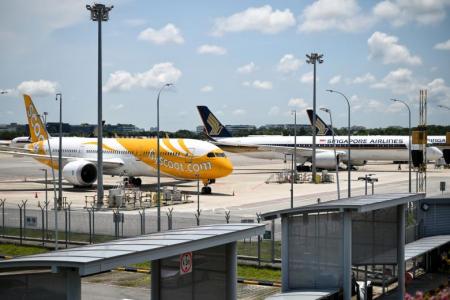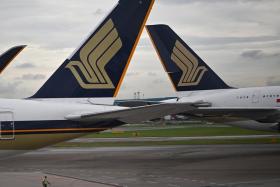Number of passengers flying SIA, Scoot doubles to almost 600,000 in December
Almost 600,000 passengers flew on Singapore Airlines (SIA) and Scoot planes in December, in its strongest set of results since the Covid-19 pandemic rapidly worsened in early 2020.
The number is almost double the figure in November, and seven times the figure in December 2020, according to data released on Monday afternoon (Nov 17).
But experts said the rate of recovery is expected to slow down in the coming months owing to the Omicron variant and the reduced quota for a quarantine-free travel scheme.
The SIA Group, which is made up of the full-service SIA and its budget arm, Scoot, said the significant increase in passenger demand in December came on the back of a continued expansion of its Vaccinated Travel Lane (VTL) flights and the year-end travel season.
It noted that eight cities - including Bangkok - have joined the SIA Group's VTL network in December.
As at end-December, the SIA Group's passenger network, including to non-VTL countries, covered 85 destinations.
SIA Group's passenger capacity is now at 45 per cent of the levels achieved in January 2020, before the pandemic grounded planes worldwide.
Meanwhile, its cargo load factor in December fell 9.9 per cent compared with the year before. This was due to the increase in cargo capacity being bigger than the increase in cargo loads, said SIA Group.
SIA's and Scoot's recovery had been boosted since the launch of the VTL scheme in September. The scheme allows travellers who are fully vaccinated against Covid-19 to enter the country without having to serve quarantine.
But following the emergence of the Omicron variant, the carriers were forced to suspend new ticket sales for VTL flights entering Singapore between Dec 23 and Jan 20.
Tickets for VTL arrivals from Jan 21 are still available, but the arrival quota has been cut by half to allow only 5,000 passengers to enter daily.
SIA Group said it expects the passenger capacity for January and February to be around 47 per cent and 45 per cent of the levels in January 2020.
Mr Mayur Patel, head of Asia at flight data and analytics provider OAG Aviation, said SIA's latest set of results are encouraging, especially on long-haul sectors.
But he cautioned that the emergence of Omicron has affected demand for travel. The absence of China, Hong Kong and Japan traffic will continue to place limitation on SIA Group's traffic growth, he said.
"The first half of the year is traditionally a slower period for travel and coupled with arrival quota cut by 50 per cent, the next few months will see softer traffic numbers, for which the airline will need to adjust its network in accordance with the prevailing market conditions," Mr Patel said.
He also said that SIA still remains in early stages of recovery in comparison with its counterparts in the Middle East hubs such as Dubai and Doha.
Independent aviation analyst Brendan Sobie from consultancy Sobie Aviation said SIA's strong end to the year was expected due to the rapid expansion of the VTL scheme and pent-up demand for outbound travel.
On SIA Group's passenger load factor, which shows the percentage of its planes' seats taken up by passengers, Mr Sobie said the figure of 47 per cent is still very low but much higher than what has been registered for most of the pandemic.
He noted that SIA is still way behind in terms of traffic recovery in comparison with the global international air travel market. It is also lagging behind Asia-Pacific carriers generally, although this is an uneven comparison due to the lack of a domestic market for SIA, said Mr Sobie.
"SIA is doing relatively well when looking at the international market in Asia-Pacific," he added.
"International traffic in Asia-Pacific remains well below pre-Covid levels with very low load factors. SIA is roughly on a par or even doing better than average."
Get The New Paper on your phone with the free TNP app. Download from the Apple App Store or Google Play Store now


